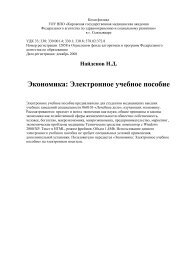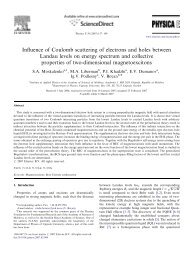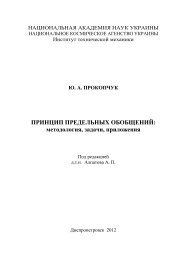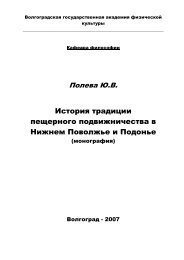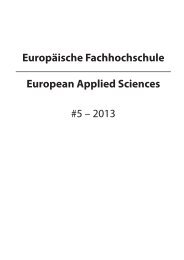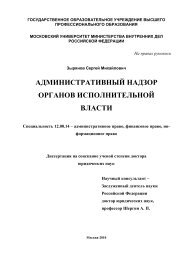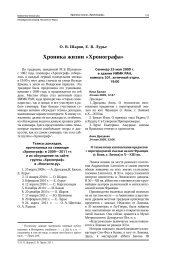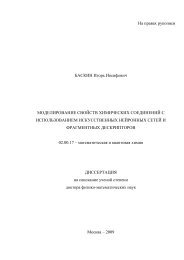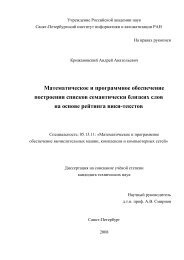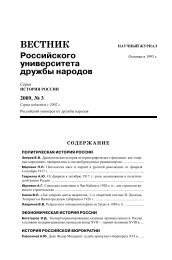sakhalin island, russian far east
sakhalin island, russian far east
sakhalin island, russian far east
Create successful ePaper yourself
Turn your PDF publications into a flip-book with our unique Google optimized e-Paper software.
Slovenský kras<br />
acta Carsologica slovaca<br />
47<br />
suppl. 1<br />
57 – 66 Liptovský mikuláš 2009<br />
Master and visitors of the cave Ostantsevaya<br />
(Sakhalin Island, Russian Far East)<br />
Irina Kirillova 1 – Nikita Zelenkov 2 – Alexey Tesakov 3<br />
1<br />
Ice Age Museum, All-Russia Exhibition Centre 71, 129223 Moscow, Russia;<br />
ikirillova@yandex.ru<br />
2<br />
Paleontological Institute of the Russian Academy o Sciences, Profsoyuznaya 123,<br />
117997 Moscow, Russia; nzelen@paleo.ru<br />
3<br />
Geological Institute of the Russian Academy of Sciences, Pyzhevsky 7,<br />
119017 Moscow, Russia; tesak@ginras.ru<br />
I. Kirillova – N. Zelenkov – A. Tesakov: Master and visitors of the cave Ostantsevaya<br />
(Sakhalin Island, Russian Far East)<br />
Abstract: The Ostantsevaya Cave (Sakhalin Island, Russian Far East) yielded rich and<br />
diverse vertebrate fauna of Late Glacial through Holocene time. The bone assemblage is<br />
dominated by remains of brown bear and hare, reindeer and snow sheep. The fauna for<br />
the first time documented the presence on Sakhalin of several mammal forms including<br />
cave lion, steppe ferret, collared lemming, and ground squirrel. The origin of the bone<br />
accumulation in the site is mainly due to natural factors, such as predators and fluvial<br />
activity, but the Early Man was also undoubtedly involved in this process. Brown bear<br />
was the most important bone-accumulating agent throughout the investigated history<br />
of the cave.<br />
Key words: Natural cave, mammals, taphonomy, Late Pleistocene, Holocene, Sakhalin,<br />
Russia<br />
Introduction<br />
Environmental changes during the Quaternary were marked by glacial and interglacial fluctuations.<br />
On Sakhalin Island, likewise in other parts of the Palaearctic, these climatic cycles<br />
caused periodical southward/northward range shifts of plant and animal associations. The<br />
Central Sakhalin located in between northern and southern parts of the <strong>island</strong> that dramatically<br />
differ in their environmental conditions. Of particular interest is the formation of the<br />
cave sediment record in a geologically short but palaeogeorgaphically very significant time<br />
interval from the Late Glacial time through the present time. These geographical and time<br />
factors defined the bone assemblage composition of the Ostantsevaya Cave.<br />
Location and origin of the cave<br />
The cave Ostantsevaya is located on the southwestern slope of the Vaida Mountain<br />
(049°51’N, 143°31’E), in the northern part of the Okada limestone massif. It represents<br />
an ancient Upper Jurassic reef assigned to the Ostrinskaya Formation. The 4.5 km long<br />
Okada Massif is located in the upper reaches of the Vitnitsa River. Its south<strong>east</strong>ern part<br />
forms the Vaida Mountain, which has two peaks (835 and 947 m).<br />
The cave has a karst origin. Flatness of walls, arches, and ceiling, as well as the ongoing<br />
entering of water clearly indicate the current activity of these karst processes.<br />
57
History of investigation<br />
Dozens of karst caves have been found in the Okada Massif since 1948, including one<br />
of the deepest (875 m) Far Eastern cave, the Kaskadnaya one. Several archaeological sites<br />
containing mammal bones (Laz Muraveika, Ikonnikova, Medvezh’ih Tragedii, Lastochkina)<br />
as well as zoogenous bone assemblages of the Late Glacial and Holocene have been<br />
investigated in details (Alekseeva, 1990, 1995; Alekseeva et al., 2004; Burova, 1998; Panteleev,<br />
2001; Kirillova, 2003). An expedition of the Pacific institute of geography of the<br />
FESC USSR AS led by Yu. I. Bersenev and expedition of Biology-Soil institute of the<br />
FESC USSR AS under the direction of M. P. Tiunov studied the karst massif of the Vaida<br />
mountain in details in 1981 – 1982.<br />
The cave Ostantsevaya was discovered by Yu. I. Bersenev in 1970-s; excavations were led<br />
by S.V. Gorbunov (Tymov regional museum) in 1994 – 1997. The cave entrances is at the<br />
attitude of 380 m a.s.l. It is 70 m higher than the local base level of the Vitvitsa River. The<br />
cave has a length of 21 m, and the area of 24 m 2 . The cave has two narrow entrances (up to<br />
2 meters heigh) which in few meters merge into a gallery with a platform and an inclined<br />
well at its end (Fig. 1). The depth of this well is about 7 meters; its area ranges from 0.5<br />
to 1.5 m 2 .<br />
Vertebrate bones were found near the cave entrance and also inside the well. Bones<br />
collected near the entrance (totally 199) were studied by E. I. Alekseeva. She has found<br />
the prevalence of the reindeer and snow sheep, the significant amount of bones of the Siberian<br />
musk deer, and a few remains<br />
of the Arctic fox, deer, hare, and<br />
horse (Alekseeva et al., 2004 and<br />
web-based report of the Poronaisk<br />
regional museum). This is the<br />
first evidence for the existence of<br />
horse on Sakhalin. Radiocarbon<br />
data showed the age of this find<br />
being older than 15 ka (Kuzmin<br />
et al., 2005). Two bones of the<br />
Gyrfalcon (Falco rusticolus) were<br />
also previously identified from the<br />
cave (Panteleev, 1997).<br />
The aim of the present paper is<br />
to characterize and reveal the origin<br />
of the vertebrate assemblages from<br />
the well of the Ostantsevaya Cave.<br />
Fig. 1. Ostantsevaya Cave: entrance view (photo), plan and profile<br />
(field drawings of S. V. Gorbunov). 14 С dates after Kuzmin et al. 2005.<br />
Material<br />
Bones from the well have been assigned to 12 conventional horizontal layers, 0.5 m<br />
each. According to S. V. Gorbunov (pers. comm.), natural layers had inclined position,<br />
particularly significant near the bottom of the well. Thus each conventional layer may include<br />
bones from at l<strong>east</strong> two natural layers. This fact does not allow for precise correlation<br />
of bone accumulation phases with the regional climatic changes, but it is still possible to<br />
reveal major factors that affected the accumulation of bones.<br />
When excavations started, the well was filled with sediments up to the level of 1.1 m<br />
below the cave floor. Flowing water and burrowing animals could have caused some<br />
mixing of the materials between layers. For example, the brown bear often burrows upper<br />
ground layers as a preparation for wintering. Noteworthy, first explorers of the cave<br />
58
noted scratches on the walls evidencing that the cave was used by wintering bears. Any<br />
of the factors mentioned above may be responsible for the inversion of the radiocarbon<br />
dates which is documented for the lower layers of the well; these data are (from the lower<br />
to upper parts of the well): 11,400; 12,700; 9,600 in the lower third, and 8,000 in the<br />
upper part.<br />
Bones from the cave were studied by I. V. Kirillova (large mammals), A. S. Tesakov<br />
(small mammals), and N. V. Zelenkov (birds). The whole collection of animal remains<br />
from the Ostantsevaya cave contains approximately 9000 bones, 4200 of which were identified<br />
up to lower taxa, including about 200 bones of ruminants and 28 bird bones. The<br />
rest are large mammals of 25 taxa (Kirillova, 2006). The majority of the avian bones is<br />
undamaged and well identifiable.<br />
All materials are catalogued by the Tymovskoe Museum of Regional Studies (TMRS).<br />
Small mammals<br />
This group of mammals is poorly represented in the collection due to the sampling methods<br />
aimed mostly at getting large size remains. Nevertheless, our material includes sporadic<br />
remains of Chiroptera indet., Eptesicus nilssoni, Ochotona cf. hyperborea, Sciuridae gen.<br />
indet., Tamias sibiricus, Spermophilus<br />
undulatus, Discrostonyx cf. torquatus,<br />
Clethrio nomys rufocanus, Clethrionomys<br />
rutilus, Microtus sp. Collared lemming<br />
and long-tailed ground squirrel were<br />
found on Sakhalin for the first time (Kirillova<br />
and Tesakov, 2005, 2008).<br />
Large mammals<br />
Taxonomic list of large mammals<br />
is given in the Table 2. The bones are<br />
generally well-preserved, as typical for<br />
karst localities. Bones are white to dark<br />
brown, usually fragmented. Sings of<br />
digestion are visible on few first and second<br />
bear phalanges that indicates an<br />
action of a large predator. More than<br />
a half of bones have scratches attributable<br />
to large carnivoran teeth (Fig. 2).<br />
Along with the animal bones, about<br />
20 stone artifacts have been found in the<br />
cave; the cut-marks are well visible upon<br />
some large animal bones (see below).<br />
Fig. 2. Tooth marks on bones: 1 – tibia of bear (No. 279-4),<br />
2 – mandible of young bear (No. 279-2144), 3 – pelves of<br />
musk deer (No. 279-986), 4 – pelves of bear (No. 279-2157),<br />
5 – first cervical vertebra of bear (No. 279-5124).<br />
Results and discussion<br />
Tables 1, 2, and Fig. 3 show that the majority of remains belongs to the brown bear<br />
and hare. They are followed by middle-sized ungulates (reindeer, snow sheep), and the<br />
red fox, while the other animals constitute a small portion of the whole number of bones.<br />
The taxonomic list of large mammals from the cave differs from the extant faunal<br />
list of the <strong>island</strong>. Along with the species that inhabit the Sakhalin Island today (reindeer,<br />
brown bear, red fox, glutton, sable and others), the fauna includes species now<br />
missing on the Sakhalin (such as, Siberian musk deer, moose, snow sheep, Arctic fox,<br />
cave lion, ground squirrel, etc.). Some of them (cave lion, large bovids, steppe ferret,<br />
collared lemming, and long-tailed ground squirrel) are the first records on Sakhalin.<br />
59
The animals from the cave can<br />
be assigned to the several ecological<br />
types: mountain (snow<br />
sheep, ground squirrel), open<br />
nival landscapes (reindeer,<br />
snowy owl, Gyrfalcon, willow<br />
grouse), boreal (lynx, sable,<br />
Siberian musk deer, spotted<br />
nutcracker, hazel grouse), forests<br />
(moose, roe, red-backed<br />
voles, chipmunk, grae-headed<br />
woodpecker), periglacial and<br />
steppe dwellers (Arctic fox,<br />
collared lemming, steppe ferret,<br />
black-tailed godwit), ecologically<br />
plastic animals (brown<br />
bear, wolf, red fox, wolverine,<br />
ermine).<br />
Table 1. Mammal remains (except small size forms), numbers and %,<br />
from the well of the Ostantsevaya Cave.<br />
Level<br />
Determinable Undeterminable Total in levels,<br />
Specimens % Specimens % specimens<br />
1 271 59 190 41.0 461<br />
2 437 62.3 264 37.7 701<br />
3 424 57.1 318 42.9 742<br />
4 735 50.3 727 49.7 1462<br />
5 198 30.0 462 70.0 660<br />
6 122 40.4 180 59.6 302<br />
7 149 49.5 152 50.5 301<br />
8 237 68.5 109 31.5 346<br />
9 250 28.5 628 71.5 878<br />
10 350 69,4 154 30.6 504<br />
11 573 37,3 963 62.7 1536<br />
12 218 44,3 274 55.7 492<br />
Total 3964 – 4421 – 8385<br />
Table 2. Taxonomic composition of mammal remains (except small size forms), %, from the well of the Ostantsevaya Cave.<br />
Animals<br />
L e v e l s<br />
1 2 3 4 5 6 7 8 9 10 11 12<br />
Lepus timidus 17.3 18.5 19.1 13.9 15.7 41.8 26.8 13.9 22.0 29.7 35.61 33.4<br />
Ursus arctos 55.8 76.6 67.9 67.2 21.7 42.7 39.6 48.5 38.4 53.4 30.02 40.7<br />
Canis sp. 0.4 – – 0.3 – – – – – – – –<br />
Canis lupus – – – – 0.5 – – – – – – –<br />
Alopex lagopus – – – – – – 0.7 – – – – –<br />
Vulpes/Alopex – 0.7 0.7 0.1 – 1.6 – – 0.4 0.3 – –<br />
Vulpes vulpes 1.1 – – 0.8 5.0 – – 2.1 3.2 0.6 1.92 2.8<br />
Gulo gulo – – – – – – 0.7 0.8 0.4 0.3 0.17 0.5<br />
Martes zibellina 0.7 – 0.5 1.0 1.0 – – 1.7 2.0 – 0.35 –<br />
Mustela erminea – 0.2 – – – – – – – – – –<br />
Mustela eversmanni – – – – – – – – – 0.3 – –<br />
Lutra lutra – – – – – 0.8 – – – – 0.17 –<br />
Mustelidae – – – 0.1 – 0.8 – – – 0.9 0.52 –<br />
Panthera cf. spelaea – – – – – – – 0.4 – – – –<br />
Felis lynx – – – – 0.5 – – – – – 0.17 –<br />
Carnivora, L – – – – – 2.5 – – – – 1.57 2.8<br />
Moschus moschiferus – 2.3 0.5 0.4 – – – – – 0.3 – –<br />
Capreolus – – – – – – – – – – 0.35 0.5<br />
Alces alces – – 0.2 – – – – – – – – –<br />
Rangifer tarandus 5.9 0.5 3.1 3.5 16.2 7.4 9.4 10.1 9.2 3.4 8.73 6.9<br />
Cervidae, L–M – – – 0.5 – – – – – 0.3 – –<br />
Perissodactyla, S – – – – 1.5 – – – – – – 0.5<br />
Perissodactyla, M 9.6 0.5 4.5 5.0 22.2 1.6 15.4 11.8 16.0 7.1 11.35 6.9<br />
Perissodactyla, L 0.4 0.2 – – 0.5 – – – 0.4 – – –<br />
Bovidae, L – – – 0.5 0.5 – – – – 0.3 0.17 –<br />
Ovis nivicola 8.8 0.5 3.5 6.7 14.6 0.8 7.4 10.6 8.0 3.1 8.90 5.0<br />
1) Bold face stands for species recorded on Sakhalin for the first time.<br />
2) Capital letters stand for size classes in mammal groups: S – small, M – medium, L – large.<br />
60
Fig. 3. Distribution of main species (more than 5 % of the<br />
assemblage) in levels of the Ostantsevaya Cave.<br />
61<br />
Birds. Avifauna from the well of the<br />
Ostantsevaya Cave comprises 7 species.<br />
The most numerous are remains<br />
of the grey-headed woodpecker (Picus<br />
canus) and the spotted nutcracker (Nucifraga<br />
caryocatactes); 8 bones of the<br />
former and 7 bones of the latter have<br />
been identified. The grey-headed woodpecker<br />
inhabits light deciduous forests,<br />
while the spotted nutcracker prefers coniferous<br />
forest with the Siberian pine<br />
which is the main food source of this<br />
species in the most of the Asian part<br />
of its range. The presence of these species<br />
throughout the depth of the well<br />
clearly indicates the presence of mixed<br />
forest landscapes during the whole period of accumulation. Other woodland species are<br />
the typical <strong>far</strong> <strong>east</strong>ern form, the white-throated needletail (Hirundapus caudacutus), and<br />
the hazel grouse (Tetrastes bonasia).<br />
The black-tailed godwit (Limosa limosa) is an open-land dweller, but today it can be seen<br />
on the Island only during migrations (Nechaev, 1991). The snowy owl is a typical representative<br />
of the Pleistocene glacial steppe tundra and is very common in Pleistocene avifaunas<br />
(Ericson and Tyrberg, 2004). Two fragments of this species were found in the well. Nowadays<br />
the snowy owl is common on Sakhalin in winter (Nechaev, 1991), but the find of this<br />
species could also indicate the presence of the periglacial landscapes. Also a bone of the<br />
grouse (Lagopus sp.) was found in the well. This genus is also a typical representative of<br />
the Pleistocene faunas in Eurasia, but the grouses still occur on the Sakhalin today. One<br />
bone of a petrel (Oceanodroma sp.) from the first layer is rather strange find, since no other<br />
marine birds or mammals are represented in the cave deposits.<br />
The predominance of the medium sized arboreal species in the collection of avian remains<br />
allows us to advocate the natural type of accumulation of bird bones. It seems to be<br />
unassociated with human activity, and could be caused by predators hunting or by occasional<br />
accumulation.<br />
Most common representatives<br />
of the cave taphocenosis<br />
Brown bear<br />
At present, the Sakhalin Island is inhabited by a comparatively large form of brown bear,<br />
though the overall size and skull morphology of this species vary in different parts of the<br />
<strong>island</strong> (Yudin, 1993). Four well preserved skulls (2 males, 2, females) have been found in<br />
the upper layers of the well; they all belonged to individuals that were smaller than the modern<br />
Far Eastern bears (Fig. 4). Bones of larger individuals were found, however, among<br />
the bear remains from the lower part of the well.<br />
Dental material from the well includes deciduous fangs of bear (totally 69). Modern<br />
bears on the Sakhalin <strong>island</strong> lose their deciduous fangs by the 14 months of life (Voronov,<br />
1972), or during the first wintering at the age of about one year (Yudin, pers. comm.).<br />
A find of a cranial fragment with erupting deciduous teeth and embryonic ulna in the<br />
layer 3 clearly indicates that animals died here in late autumn or in winter. In addition,<br />
growth marks on the outer surface of the tooth roots show that death occurred during
Fig. 4. Bear sculls: 1 – Modern male from the upper reaches<br />
of Bikin River (Primorie Territory), 2 – (No. 279-378),<br />
3 – (No. 279-977) and 4 – (No. 279-3390) correspondingly<br />
from lavels 1, 2, and 4 from the well of the Ostantsevaya Cave.<br />
Marks on the scull 2 can me of the artificial origin. Orifice<br />
on frontale of the scull 3 are human made: a stone tool have<br />
been found inside the scull. The scull No. 4 bears a treck from<br />
a strong impact of a heave object on nosale (shock zone).<br />
Fig. 5. Natural reach-through hole in ulnar facet of bear humeri<br />
from lavel 4: 1 – 2, one adult animal; 3 – juvenile animal.<br />
62<br />
non-growing period, specifically a cold<br />
season in specimen no. 279-1554, or<br />
at the very end of a cold season in no.<br />
279-1551.<br />
The fact that bears died in the cave<br />
during cold seasons together with the<br />
find of numerous deciduous teeth throughout<br />
the whole sequence of the<br />
well indicate that the Ostantsevaya<br />
Cave was used as a den for thousands<br />
of years.<br />
Interestingly, remains of a few inspected<br />
adult individuals, according to<br />
the method of Klevezal (1996), died<br />
in warm season. Normally bears spend<br />
warm seasons outside their winter<br />
dens. This may indicate that not only<br />
natural type of accumulation played a<br />
role in the forming of the cave taphocenosis.<br />
However, we should keep it in<br />
mind that old and sick animals often<br />
stay in a shelter till they die, and the<br />
cave is such a suitable shelter.<br />
Many humeral bones of the brown<br />
bear show foramen located proximally.<br />
Totally 5 fragments out of 8 distal humeral<br />
bones found in the layers 3, 4,<br />
and 8 have this feature (Fig. 5). This<br />
feature is not mentioned as common<br />
in other bear localities. In humans it<br />
is a discrete and heritable character<br />
(Drobyshevsky, 2006). Since the general<br />
morphology of the human and<br />
bear humerus is similar, this character<br />
may be also inheritable in bears. In this<br />
case, this trait may be common for the<br />
local population of bears. According<br />
to Yudin (pers. comm.), bears from the<br />
different parts of Sakhalin vary in skull<br />
morphology and size. It is possible that<br />
these humeri with foramen originate from females since they possess more gracile skeleton.<br />
The prevalence of females in the cave taphocenosis would not be surprising when<br />
taking into account their denning behavior.<br />
In the Russian Far East, female brown bears usually winter in dens or other shelters due<br />
to reproduction reasons. On the contrary, male brown bears often winter in shallow rock<br />
shelters or even under rocks or trees. Moreover, females with cubs or younger males are<br />
relatively easy prey for a larger bear or other predator (cave lion, human). Cannibalism is<br />
common in mainland populations of bears where it often reflects limited resources. But<br />
it is not typical for recent <strong>island</strong> populations and, in particular, for bears of Sakhalin, because<br />
of perfect feeding conditions, including fish in spawning streams (Yudin, 1993). At
the same time animals that died during winter still can be utilized by carnivorous animals<br />
later, for example, early in the spring. This can explain abundant tooth marks on bear<br />
bones from the well.<br />
Tooth marks on the second cervical vertebra from the layer 10 deserve a special note<br />
(Fig. 2.5). This can be an evidence of killing rather than just a consuming. Bear attacks<br />
large prey by breaking its backbone with the paw strike. When bears eat cervical parts of<br />
their prey they leave gnaw marks on pointed parts of vertebrae (or utilize them entirely).<br />
Therefore, this mark can be alternatively attributable to a large pantherine cat. These animals<br />
hunt on bears and the manner in which they kill bears was described in the literature:<br />
“Especially large tigers… successively hunt bears of the nearly equal weight… Tiger jumps<br />
on a bear from above, holds its chin by one front paw, and its neck by another paw, simultaneously<br />
biting through its cervical vertebrates… (Baikov, cited after: Ognev, 1935). Yudin<br />
(pers. comm.) also confirm the fact that tiger kill prey by cutting its neck. It will be correct<br />
to extrapolate this hunting behavior to the cave lion, represented in the well material by a<br />
deciduous tooth (Kirillova and Tesakov, 2008).<br />
Hares<br />
Hare remains are second most abundant element of the assemblage after the brown bear.<br />
The hare is a preferred prey for a number of predators. Adults and juveniles are nearly equally<br />
represented in the lower part of the well, but this ratio shifts toward the prevalence of<br />
juveniles in the upper layers. We propose the following explanation for that: when the well<br />
was empty, both juveniles and adults would die when occasionally trapped inside, but after<br />
the well filled with sediments, only juveniles could not escape this natural trap.<br />
Remains of hare are often numerous in cultural layers of the late Paleolithic; they are<br />
abundant in zoogenous bone assemblages, especially those connected with the eagle-owl<br />
activity. In our case, however, no signs of partition or special patterns of fragmentation<br />
are evidenced. Most probably their accumulation was caused by an activity of birds of<br />
prey. Taphonomically similar condition is described in details for another site of the Vaida<br />
Mountain, the Lastochkina Cave (Burova, 1998).<br />
Middle size ungulates<br />
The reindeer and snow sheep fall in this category. Their remains constitute a significant<br />
part of the total number of bones (see above). Bones of these animals often bear teeth<br />
marks, they are often rolled (presumably due to the water flow in the well) and fragmented.<br />
Some of them bear cut marks. Adult remains prevail. The accumulation of ungulate bones<br />
is most likely connected with predators’ activity.<br />
Human artifacts in the Ostantsevaya Cave<br />
Three of four almost complete brown bear skulls from the well show obvious marks of<br />
human impacts. Thus, the left half of the os frontale of an older male skull (specimen no.<br />
279-977; Layer 2) has two rounded openings (Fig. 4.3) measuring 18 by 13.8 and 11.2 by<br />
10.8 mm. The right squamosum of this specimen is also punched out. These openings<br />
are rimmed by cracks running from them. Detailed study of these skulls shows that these<br />
openings had been made when the skull was yet fresh. Lower jaws of this skull lack articulate<br />
processes, and the coronal processes are also missing or strongly damaged. Another<br />
example is a skull of mature female (specimen no. 279-3390; Layer 4). The base of nasal<br />
bones has an obvious linear mark indicative of a strong straight punch which was made by<br />
a huge object (Fig. 4.4). This trace is 37 mm long, 3 – 3.5 mm wide, and 1mm deep. This<br />
stroke apparently was fatal, and produced a large crack, passing through the sagittal crest.<br />
Finally, an opening 9 × 8 mm and a 40 mm long trace in the skull no. 279-378 (Layer 1)<br />
are also most probably produced by humans.<br />
Some of the lower jaws from the Layer 10 have similar injuries of the ascending process<br />
(Fig. 6), which is the evidence of human activity. Most likely, they were made during the<br />
63
splitting the lower jaws from the skulls.<br />
Marks on a fibula of the brown bear<br />
(Fig. 7) indicate a stroke, and of no doubt<br />
artificial. One femur of the brown<br />
bear show cut-marks made during the<br />
removing of the flesh from the bone;<br />
traces on a pelvic bone (Fig. 7) obviously<br />
have similar origin.<br />
Further worth to be mentioned are<br />
similar holes on four astragals of the<br />
middle sized ungulates from the layers<br />
4 and 11. Similar holes likewise<br />
common in sites of ancient hunters of<br />
Mesolithic and Neolithic, and are sometimes<br />
referred as to a signs of marrowbone<br />
extraction. But this bone is<br />
too thick and the quantity of the marrowbone<br />
is too small. Most probably<br />
these bones served as parts of composite<br />
tools.<br />
The overall small quantity of artifacts<br />
and burned bones, together with<br />
rare signs of human impacts on animal<br />
bones indicate the irregular occurrence<br />
of humans in the cave. E. Alekseeva<br />
(pers. comm.) speculated on a ritual use<br />
of the cave.<br />
Fig. 6. Homogeneous artificial damages of bear mandibles<br />
(possible cutting of ascending parts of lower jaws during their<br />
divison from sculls). No. 279-1105, 279-713, 279-1104, 279-<br />
1106.<br />
Conclusions<br />
The process of vertebrate remains<br />
accumulation in the Ostantsevaya Cave<br />
took a long time from the latest glacial<br />
to the second half of the Holocene. Radiocarbon<br />
data from the bones range<br />
from 16 to 8 ka. During all or at l<strong>east</strong><br />
part of this time interval, environmental<br />
conditions were different from those<br />
found on the <strong>island</strong> nowadays, that<br />
Fig. 7. Human produced marks of bones. 1 – cutting of bear<br />
pelves (No. 279-884), 2 – artificial hole on calcaneal of a medium<br />
size ungulate (No. 279-1516), 3 – impact of pointed object<br />
on fubula of bear (No. 279-888), 4 – signs of narrow blade<br />
on proximal part of bear tibia (No. 279-694) (fragment),<br />
possibly originated during butchering.<br />
is evident from the remains of horse, large bovids, suslik, steppe ferret, and cave lion – because<br />
all of them are absent on the Sakhalin at present.<br />
Heterogeneous taxonomic list of animals from the cave documents changes in environmental<br />
conditions. Various animals represent different environments: horse, large ungulates,<br />
hor, ground squirrel, and collared lemmings indicate the presence of open habitats that<br />
nearly entirelly missing on the Sakhalin today, whereas reindeer and lynx, sable, musk deer,<br />
moose, and roe indicate the presence of semi-open forests. The cave was also inhabited by<br />
early humans, but signs of their presence are rare.<br />
Osteological materials from the cave contain information on events that occurred in<br />
the cave and in its neighborhood throughout the thousands of years. The cave was a<br />
natural trap for some animals, bones of consumed animals accumulated here as well,<br />
64
and the brown bears, the main visitor of the site, accidentally died here during winter<br />
seasons. These are obviously the main factors that influenced the accumulation of vertebrate<br />
remains.<br />
Most likely, the cave was an efficient trap for smaller animals, like hares and foxes, while brown<br />
bears could die here during the period of the intensive snow melting, or hard rains. Since the<br />
cave was a good wintering place for bears, cases of cannibalism and intraspecific hunting (as<br />
well as that by humans) were common here. Most probably, both humans and other predators<br />
(brown bear, fox, panthera, and wolf) consumed their prey here. The Ostantsevaya Cave is the<br />
first documented evidence of the interaction between the brown bear and Panthera, which is<br />
evident from the find of a vertebra of bear with the teeth marks attributable to a pantherine cat.<br />
Although the assemblage of bones from the cave is polygenous, the key figure and the<br />
main participant of this historical scenario was the brown bear.<br />
References<br />
Alexeeva, E. V. 1990. Archaeozoological studies on Sakhalin. Bulletin of the regional museum, Yuzhno-Sakalinsk,<br />
1, 48–49. (in Russian)<br />
Alexeeva, E. V. 1995. Fossil remains of snow sheep in Sakhalin.Vestnik of the Far East Devision of<br />
the Russian Academy of Sciences, Vladivostok, 6, 92–93. (in Russian)<br />
Alexeeva, E. V. – Rakov, V. A. – Gorbunov, S. V. 2004. The Catalogue of Archaeological Monuments<br />
of Sakhalin with Shell Accumulations and Faunal Remains. Materials of the Tymovskoe<br />
Museum, Tymovskoe, 1–82. (in Russian)<br />
Baikov, N. A. Manchurian tiger. Cit. after Ognev S. I. 1935. The mammals of the USSR and adjacent<br />
countries 3, Fissipedia and Pinnipedia. Biomedgiz, Moscow-Leningrad, 1–752. (in Russian)<br />
Burova, N. D. 1998. Taphonomic analysis of small mammal accumulations in cave deposits (the case<br />
of Holocene remains from Lastochkina Cave, Sakhalin). Abstracts of All-Russian conference for<br />
Quaternary studies, VSEGEI, St. Petersburg, 227. (in Russian)<br />
Drobyshevsky, S. V. 2006. Predecessors. Ancestors Paleoanthropes. Komkniga, Moscow, 1–264.<br />
(in Russian)<br />
Ericson, P. G. P. – Tyrberg, T. 2004. The early history of the Swedish avifauna. A review of the<br />
fossil record and early written sources. Kungl. Vitterhets Historie och Antikvitets Akademiens<br />
Handlingar, Antikvariska Serien, 45, 1–349.<br />
Kirillova, I. V. 2003. Remains of vertebrates from the Tronnyi Cave (Central Sakhalin). Problems<br />
of the history of Sakhalin, Kuril Islands, and neighboring areas. Transaction of the regional museum,<br />
Yuzhno-Sakhalinsk, 2, 128–137. (in Russian)<br />
Kirillova, I. V. 2006. Holocene mammals of central Sakhalin (Ostantsevaya Cave). In Savinetsky, A.<br />
B. (Ed.): Dynamics of recent ecosystems over Holocene. Proceedings of the Russian scientific<br />
conference. KMK Scientific Press, Moscow, 92–98. (in Russian)<br />
Kirillova, I. V. – Tesakov, A. S. 2005. Remains of ground squirrels in Late Pleistocene deposits of<br />
the Ostantsevaya Cave (Sakhalin Island). In Sousliks of Eurasia (genera Spermophilus, Spermophilopsis):<br />
origin, systematics, ecology, ethology, and species diversity conservation, KMK<br />
Scientific publishers, Moscow, 43–44. (in Russian)<br />
Kirillova, I. V. – Tesakov, A. S. 2008. New mammalian elements of the Ice Age assemblage on the<br />
Sakhalin Island Ice Age mammals from Sakhalin. Mammal Study, 33, 87–92.<br />
Klevezal, G. A. 1996. Recording structures of mammals in zoological studies. Nauka, Moscow,<br />
1–286. (in Russian)<br />
Kuzmin, Ya. V. – Gorbunov, S. V. – Orlova, L. A. – Vasilevky, A. A. – Alekseeva, E. A. – Tikhonov,<br />
A. N. – Kirillova, I. V. – Burr, G. S. 2005. 14 C Dating of the Late Pleistocene Faunal Remains<br />
from the Sakhalin Island (Russian Far East). Current Research in Pleistocene, 22, 78–80.<br />
Nechaev, V. A. 1991. Birds of the Sakhalin Island. Far Eastern division of the USSR Academy of<br />
65
Sciences, Vladivostok, 1–748. (in Russian)<br />
Panteleev, A.V. 1997. Bird bones from early human sites on Sakhalin Island. Vestnik Kraevedcheskogo<br />
Museya. Yuzhno-Sakhalinsk, 4, 281–285. (in Russian)<br />
Voronov, V. G. 1972. Age changes in scull of brown bear. In: Ecology, morphology, protection, and<br />
use of bears (materials of the conference). Nauka, Moscow, 24–26. (in Russian)<br />
Yudin, V. G. 1993. Sakhalin and Kuril Islands. In Vasifeld M. A. – Chestin I. E. (Eds.): Bears. Brown<br />
Bear, Polar Bear, Asian Black Bear. Distribution, ecology, use and protection. Nauka, Moscow,<br />
403–419. (in Russian)<br />
Хозяин и посетители пещеры Останцевая (остров Сахалин)<br />
Резюме<br />
Описана фауна позвоночных позднего ледниковья и голоцена из пещеры Останцевая<br />
(остров Сахалин, Дальний Восток России). Среди костей доминируют остатки бурого<br />
медведя и зайца; заметна доля северного оленя и снежного барана. Некоторые виды<br />
млекопитающих, включая пещерного льва, степного хоря, копытного лемминга и суслика,<br />
впервые найдены на Сахалине. Накопление костных остатков в пещере связано в основном<br />
с естественными процессами (деятельностью хищников и водных потоков); несомненно<br />
также участие древнего человека. Активность бурого медведя была основным фактором,<br />
обусловившим накопление костей в течение всего времени формирования ориктоценоза.<br />
Vládca a návštevníci jaskyne OstanCevaja<br />
(Sachalin, Ruský Ďaleký Východ)<br />
Zhrnutie<br />
Jaskyňa Ostancevaja na ostrove Sachalin (ruský Ďaleký východ) predstavuje bohaté nálezisko<br />
rôznorodej fauny stavovcov z obdobia neskorého glaciálu až holocénu. V akumulácii kosťových pozostatkov<br />
dominuje medveď hnedý, zajac, sob a horská ovca. Nájdená fauna prvýkrát dokumentuje<br />
prítomnosť viacerých cicavcov na ostrove Sachalin, a to vrátane veľkých cicavcov, ako jaskynný<br />
lev, stepná fretka, golierikatý lumík a dlhochvostá zemná veverica. Vznik akumulácie kostí v jaskyni<br />
odzrkadľuje prirodzené procesy, mnohé nájdené znaky svedčia o aktivite predátorov a fluviálnom<br />
transporte. Podľa nálezov možno usudzovať, že najvýraznejším faktorom ovplyvňujúcim akumuláciu<br />
kostí počas depozície skúmaného sedimentárneho záznamu bol pobyt a aktivita medveďa hnedého<br />
v jaskyni Ostancevaja.<br />
66



